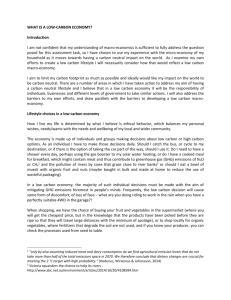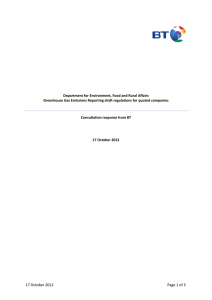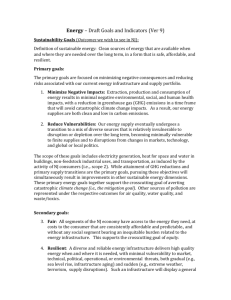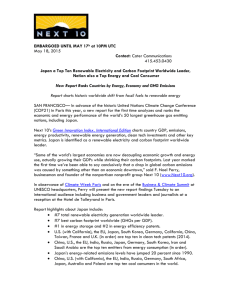Draft recommendations and timetable for achieving "Climate Neutrality“ March 13, 2012 Paul Pancella, for the subcommittee
advertisement
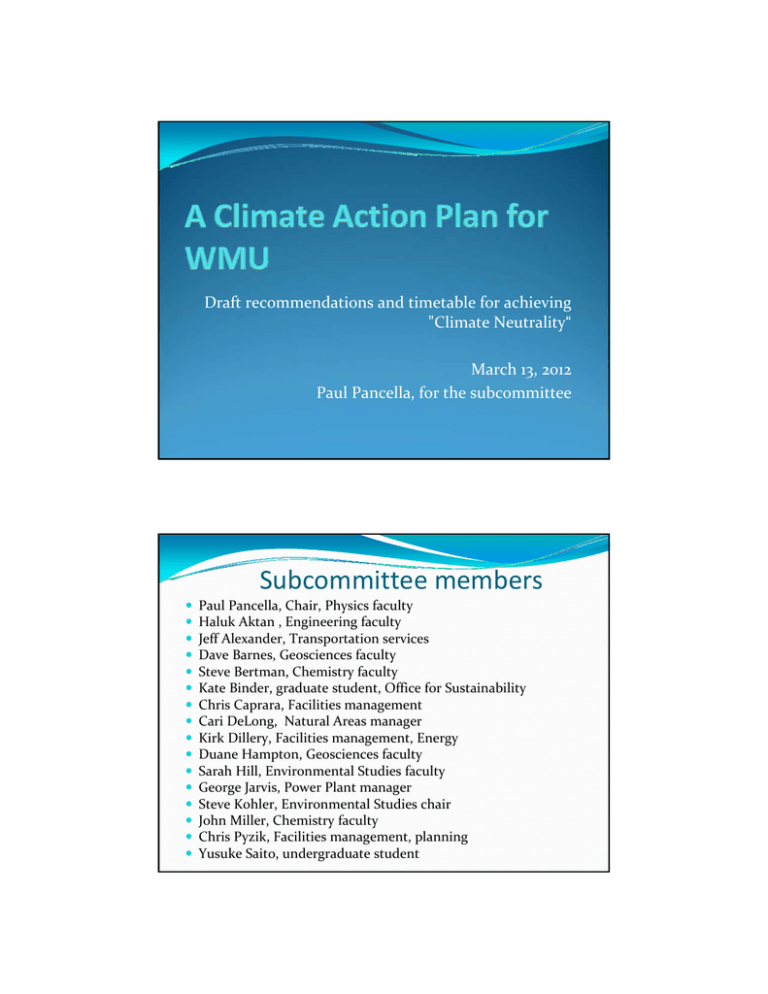
Draft recommendations and timetable for achieving "Climate Neutrality“ March 13, 2012 Paul Pancella, for the subcommittee Subcommittee members Paul Pancella, Chair, Physics faculty Haluk Aktan , Engineering faculty Jeff Alexander, Transportation services Dave Barnes, Geosciences faculty Steve Bertman, Chemistry faculty Kate Binder, graduate student, Office for Sustainability Chris Caprara, Facilities management Cari DeLong, Natural Areas manager Kirk Dillery, Facilities management, Energy Duane Hampton, Geosciences faculty Sarah Hill, Environmental Studies faculty George Jarvis, Power Plant manager Steve Kohler, Environmental Studies chair John Miller, Chemistry faculty Chris Pyzik, Facilities management, planning Yusuke Saito, undergraduate student Acronyms, abbreviations, jargon Sustainability ACUPCC Carbon footprint GHG Climate Neutrality zero net GHG emissions PUSC CAP eCO2 Mitigation Purchased offsets Sequestration Absorption Context Review President signed ACUPCC in July, 2009 We need to choose a target date and develop a plan to make WMU climate neutral by that date The final plan must be approved by WMU administration and submitted by April 15 of this year Interesting facts: President Dunn is now a member of the ACUPCC Steering Committee, its chief governing body. Although 674 colleges and universities have signed on to the ACUPCC, we are the only research/doctoral university in Michigan to do so to date. 13 other colleges and universities in MI have signed. Timeline to date July 2009: The commitment is made 2010 second GHG inventory done, covering 2009, but extrapolated from more detailed 2008 inventory Late 2010: PUSC charges me to develop the CAP, I begin to form a committee and do background research May 2011, committee starts meeting for real Fall 2011, draft recommendations shared with PUSC, Faculty Senate, and VP business & Finance Early 2012, putting the final touches on, responding to feedback Required elements of the plan: Introduction, contains prior accomplishments, geographical boundaries, other context, and the target date for neutrality. We have chosen 2065 AD II. Current GHG Emissions, recent trends, projections for future growth in operations III. Strategies for reducing GHG emissions IV. Educational Efforts, plans to integrate climate change into the general curriculum V. Planned research efforts relevant to climate change VI. Community Outreach plans VII. How we plan to finance the recommendations VIII. Tracking Progress, interim targets, structures for implementation and assessment I. Assumptions, philosophy System boundary: WMU in Kalamazoo Includes Engineering College, not BTR, not Aviation Does not include WMU medical school, a separate entity Growth projections: A. B. 1. 2. C. D. E. F. Total enrollment will slowly increase to 26,500 head count (target of current administration). Fraction in Kalamazoo unchanged. Physical Plant will grow very little in the foreseeable future (+4% in current model) A larger fraction of undergrads will live on campus in the future, due to new construction and renovation No major increase in revenue is foreseen for the next few decades No major changes in how we do business are assumed We want our report to be concise and realistic, overall approach could be described as conservative, certainly not radical Current GHG emissions, metric tons eCO2 Scope I: • Stationary Combustion • Direct transportation (campus vehicles) • Fugitive emissions Scope II: • Purchased power from utility Scope III: • All Commuting (25740) • Travel (outsourced but paid for by the university, including study abroad) • Solid Waste • Wastewater treatment • Overhead from scope II A finer breakdown GHG reduction strategies Starting with the small stuff All university‐owned vehicles to be zero‐net‐carbon fueled or electric by 2040 (50% moved to electricity) Encourage alternatives to air travel. Require purchased offsets for 100% of air travel by 2020. Eliminate fugitive emissions by 2050. Continue to work on increasing recycling to reduce solid waste stream. Continue to develop local composting (affects solid waste and wastewater). Target is 80% reduction in GHG impact in these two categories combined by 2065. Other negative inputs are also small stuff. GHG reduction strategies: the BIG STUFF That leaves the three major sources, which are really only two: Stationary combustion (our own power plant) Electricity purchased from the utility company Commuting The first two are combined to satisfy the need for centralized power, currently in the form of electricity and pressurized steam General Energy Demand reduction is crucial Perform campus‐wide energy audit to identify next round of efficiency/conservation projects. Continue to reduce demand with maintenance, renovation, and replacement projects financed by a revolving fund. Comply with recently revised Facilities Life Cycle Design Guidelines. When buildings are renovated/replaced, observe at least LEED silver requirements. Enforce Climate Savers Computing Initiative and Energy Star Purchasing policy Decrease/eliminate architectural lighting (exterior lighting not contributing to safety) Close, demolish, or dispose of underutilized buildings on East Campus and elsewhere Trend in electricity use Trend in Steam use Purchased electricity Demand reductions, load leveling, and the assumption that we will eventually be able to send our own power to the Parkview campus means no electricity purchased after 2035 State renewable energy portfolio standards reduce carbon impact of purchased electricity in the near term, 10% by 2015 Further reductions in GHG intensity likely in later decades, but not very relevant Commuting Increase the amount of desirable on‐campus housing for students significantly. Add 3500 beds by 2035. Facilitate car‐pooling for employees who work regular hours. (online tools?) Continue to support/improve mass transit options. Incentivize alternatives to single‐occupancy automobiles via: Infrastructure improvements, smoother connections for non‐motorized traffic in several directions, better snow clearing, clarifying conflict points between pedestrians, bikes and cars, financial incentives through the parking pass system? Power Plant Continue operating natural gas fired co‐generation plant as is for next ~25 years Use this time to study and determine a way to deliver future centralized electricity (and heat) base demand in a way that emits much less GHG Implement these major changes in perhaps two phases, the first in ~2042 and the second in ~2055 End state is a centralized facility capable of meeting remaining power demands with only 6% of today’s GHG impact per delivered energy Specific technology(ies) not yet determined Renewable Energy We will recommend ramping up distributed sources of renewable energy starting immediately Again, specific technology could change, but we model the financing of this on current grid‐tied photovoltaic panels, mounted at ground level or on building roofs This has the effect of reducing the demand on the centralized power plant further Must also include thermal collection, via solar panels and probably some shallow geo‐thermal heating (cooling) at some favorable sites New buildings must be built with all this in mind Distributed renewable is distinct from centralized renewable In the model I am showing, distributed renewable electricity is only 9% of total electric demand at the target date, intermittency not a problem at this level. One or the other phase of the central power plant changeover could be solar or wind, but would require additional cost & effort to develop energy storage capacity. Analysis on the steam/heat side is not as well developed. Education efforts PUSC has discussed this, in the context of sustainability across the curriculum; many of the same ideas will apply We believe that this Study Group also has a role to play here, and would like to mention that in the final draft of the report We will also look to you for participation in future committees charged with assessment of interim targets, possible course corrections going forward Questions? V Research Efforts Carbon capture and sequestration Advancing practical, local, energy storage methods Renewable energy generating technologies New technologies for energy management and conservation in buildings and manufacturing Biomass as an energy source for stationary power generation or as fuel for transportation VI Community Outreach Office for Sustainability should coordinate several efforts in this area, with contributions from Environmental Studies Program, Lee Honors College, SSE and possibly other RSOs. Increase the profile of past and future GHG reduction efforts by producing web site content, utilizing social networking, periodic press releases, and perhaps a specialized public lecture series. We could also organize some of the experts on campus to make consultation services available to the public at some level, on the model of the cooperative extension service at land grant universities VII Tracking Progress Schedule for Progress Reports Who is responsible Interim Targets 6‐year cycle Options if targets are not met in the interim



